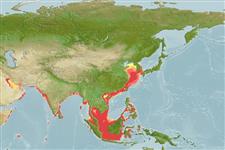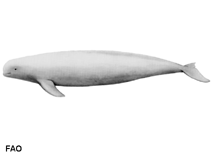Neophocaena phocaenoides (Cuvier, 1829)
Finless porpoise| Native range | All suitable habitat | Point map | Year 2050 |

|
| This map was computer-generated and has not yet been reviewed. |
| Neophocaena phocaenoides AquaMaps Data sources: GBIF OBIS |
Классификация / Names народные названия | синонимы | CoL | ITIS | WoRMS
Mammalia | Cetartiodactyla | Phocoenidae
Environment: milieu / climate zone / пределы глубины / distribution range экология
пелагический; анадромный (ссылка 75906); пределы глубины 0 - 250 m (ссылка 356). Tropical; 90°N - 7°S, 46°E - 130°E
Distribution страны | регионы FAO | Ecosystems | места находок | интродукции
Indo-West Pacific and Asia Inland Waters: Neophocaena phocaenoides phocaenoides: Persian Gulf, South China Sea, East China Sea, Indonesia, Philippines, Turtle Islands, Sulu Sea; Neophocaena phocaenoides sunameri: China, Korea, Japan, East China Sea; Neophocaena phocaenoides asiaeorientalis: Yangtze River, China (Ref. 1522). Found in tropical to warm temperate coastal waters (Ref. 81021).
Length at first maturity / Size / Weight / Возраст
половая зрелость: Lm 140.0, range 135 - 145 cm Max length : 227 cm TL самец/пол неопределен; (ссылка 81030)
Life cycle and mating behavior половая зрелость | размножение | нерест | Eggs | Fecundity | Larvae
Основная ссылка
ссылки | координатор | соавторы
Tan, J.M.L. 1995 A Field Guide to the Whales and Dolphins in the Philippines. Makati City: Bookmark. 125 p. (ссылка 936)
Статус Красного Списка МСОП
(ссылка 130435: Version 2025-1)
Статус СИТЕС (ссылка 108899)
CMS (ссылка 116361)
Угроза для людей
Использование человеком
рыболовство: коммерческий
FAO - рыболовство: landings, Видовой профиль | FishSource | Sea Around Us
инструменты
дополнительная информация
ресурсы в Интернет
BHL | BOLD Systems | CISTI | DiscoverLife | FAO(рыболовство: Видовой профиль; publication : search) | Fishipedia | GenBank (Геном, Нуклеотид) | GloBI | Gomexsi | Google Books | Google Scholar | Google | PubMed | Tree of Life | Wikipedia (Вперёд, поиск) | Zoological Record



